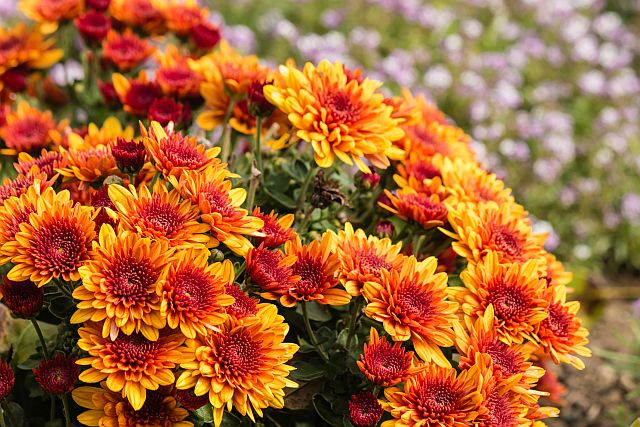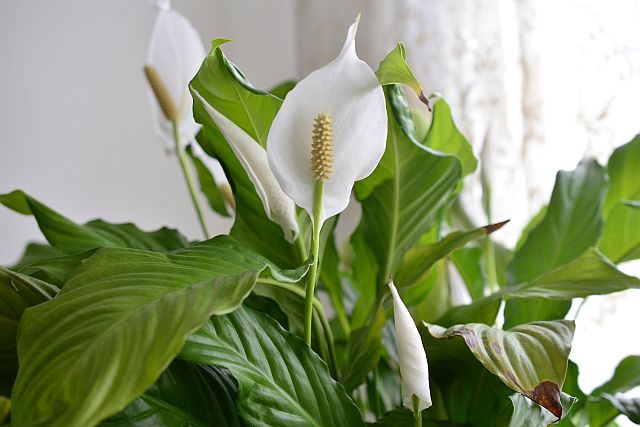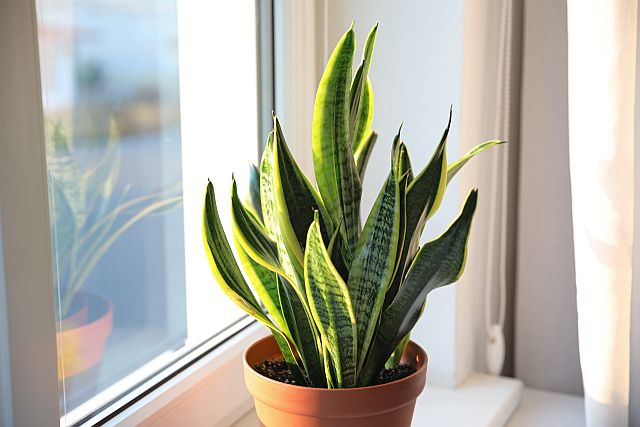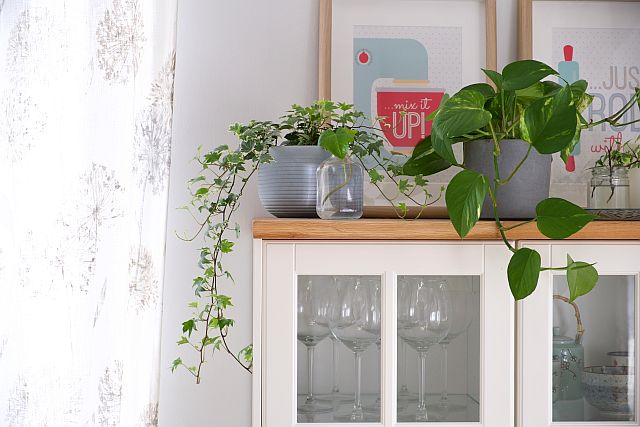Indoor plants are attractive, relaxing, and a great way to personalise your rental. They can also be packed up and taken with you when you move. However, there is much more to some humble houseplants than meets the eye because… these rather special indoor plants have a proven ability to clean the air by absorbing toxic chemicals like formaldehyde, benzene, xylene/toluene, trichloroethylene, and ammonia.
To uncover the best plants for indoors to clean the air and improve your health, we went on an air-purification houseplant hunting mission. Along the way, we found some surprising candidates for our list. We learned that some of the top indoor plants (scientifically proven) for indoor air pollution abatement include Chrysanthemums, Peace Lilies, Palms, the Snake Plant, and Dracaenas.
Best Air Purifying Plants For Indoors
If you’d like to know how plants remove toxins from enclosed spaces, contribute to cleaner air, and the common toxins they remove, read our article here (these are the toxins we refer to throughout this article). Generally, though, plants take in carbon dioxide as part of the photosynthesis process, and release clean oxygen. They also absorb soil and airborne contaminants via their leaves and roots, and either break them down or store them.
Plants respire too, which involves taking in oxygen and producing carbon dioxide. However, most plants do this at night when they can’t photosynthesise sunlight. The Sword Plant is an exception; it continues to produce oxygen at night.
So, with all that in mind, here are 16 of the best interior landscape plants we’ve found for improving indoor air quality and producing clean air.
1. Chrysanthemums (Chrysanthemum morifolium)
Chrysanthemums are possibly not the first plant that springs to mind when considering air-purifying plants. Indeed, they are more commonly associated with cut flowers and outdoor gardens…
‘Mums’ are native to China and have been used in traditional Chinese medicine for centuries. They are popular as cut flowers and add a bright splash of colour to outdoor spaces. However, they are also relatively easy to grow inside, or on a sunny patio or veranda. Just make sure they get plenty of sunshine or are placed in a nice bright spot with direct light.
Mums: Number 1 of all air-purifying plants
Along with Peace Lilies, the humble Mum comprehensively exceeded expectations when tested on common harmful toxins found in residential environments. This is why the pretty flowering plant takes out number 1 spot on our list of top air purifying plants.

2. The Peace Lily (Spathiphyllum)
Second on our list of plants that make effective indoor air purifiers is the Peace Lily, not to be confused with the Arum or Calla Lily.
The Peace Lily is native to tropical Southeast Asia and the Americas. Like most tropical plants, they like filtered light and slightly moist soil so water regularly. They have an elegant white spathe with a gold spadix.
Peace Lilies: top air-purifying indoor plants
A NASA study found the Peace Lily is an excellent air purifier and one of only a few plants capable of removing all tested compounds plus ammonia.
NB: Peace lilies are toxic to pets so if you have a pet-friendly rental, this may not be the best choice of houseplant.

3. Palms
We couldn’t separate these 3 palms so we’ve included them all!
The Bamboo Palm (Chamaedorea seifrizii), Parlour Palm (Chamaedorea elegans), and broad Lady Palm (Rhapis excelsa) are very effective air-purifying plants. The Bamboo and Parlour Palms are small rainforest palms from Mexico and Central America. Lady Palms are a cultivated species developed in Taiwan and Southern China. These palms all have hand-shaped fronds.
Bamboo Palms have multiple stalks (like bamboo) and lush green fronds. It likes humidity, medium light conditions, and just the right amount of water. It also keeps spider mites away.
The Parlour Palm is a small palm, great for growing indoors, and hardier than the Bamboo Palm. It’s actually one of the easiest palms to grow indoors.
Lady Palms are popular, easy to maintain, and suit a variety of locations around the home. They are densely clustering and, if grown in low light conditions, retain their dark green leaves. However, they also do well in bright semi-shaded positions outdoors, or in bright indoor areas, and grow to around 3 to 4 metres.
Palms: very effective all-round air-purifying plants
Palms generally are good air cleaners because they have a lot of foliage and can process a correspondingly large amount of air. The Parlour and Lady Palms effectively remove all tested chemicals and ammonia whilst the Bamboo Palm only misses the mark on ammonia. In fact, according to a series of studies, the Parlour and Lady Palms along with the Peace Lily and Chrysanthemum are 4 of only 5 plants tested that remove all these toxins.
4. Snake Plant (Sansevieria)
The hardy Snake plant (AKA Mother-In-Law’s Tongue or Sword plant) with its leathery sword-like leaves hails from West Africa and is an easy-to-care-for succulent. Snake plants love indirect light and will thrive in low light conditions. However, they’re also adept at coping with bright light, which makes them an ideal indoor plant for multiple locations.
Snake plants will tolerate a certain amount of neglect so if you forget to water them, they won’t curl up and die. In fact, they prefer dry, well-draining soil because they are prone to root rot so definitely let your Snake plant dry out between waterings.
Snake plants: good air-purifying plants to improve indoor air quality
A Snake plant removes benzene and formaldehyde from the air but will also clear away xylene/toluene and trichloroethylene. Unlike most plants, it continues to absorb carbon dioxide, and release oxygen, at night too.

5. Dracaenas
Four cultivars of dracaena make our list because they can all remove everything bar ammonia from your home.
The Dracaena fragrans cultivars come from the African tropics – Sierra Leone, Cameroon, the Ivory Coast etc. It has 2 cultivars on our list of top air-purifying plants.
- The Janet Craig dracaena or Cornstalk Plant is a popular indoor houseplant with vigorous upright growth and glossy, dark green leaves. It is easy to maintain, and isn’t fussy about light conditions (but does prefer medium to bright indirect light). Regularly water but let the soil get dry between waterings.
- Massangeana, or the Corn Plant, has long sword-shaped green leaves with a yellow stripe down the centre. It prefers medium light but will survive in low light although its vibrant yellow stripe often fades in those conditions. As with Janet Craig, let the soil dry out before watering.
Dracaena deremensis has one cultivar on the list. Warneckeii has striped green and white leaves and is known as the Striped Dracaena. Its native habitat spans much of tropical Africa from Mozambique to Cameroon. It requires well-draining soil and moderate to bright indirect light.
Dracaena marginata also has one cultivar with proven air-purifying qualities. The Madagascar Dragon Tree or Red-edged Dracaena has long thin leaves with a distinctive red/purple edging. As its common name suggests, the cultivar is native to Madagascar and neighbouring islands. Unlike the 3 dracaena cultivars above, this one prefers bright light. It also doesn’t like being over-watered.
Dracaenas: dramatically improve air quality and indoor air pollution
Janet Craig is particularly effective at clearing formaldehyde but can also make a big dent in benzene and trichloroethylene.
The Red-edged Dracaena is the best for removing trichloroethylene but has a formidable reputation against benzene as well.
Warneckeii is best for removing benzene but the least effective against formaldehyde and roughly equal with Massangeana for trichloroethylene
Massangeana is the least effective of the 4 cultivars but is still far more effective than many other plants as it does work for 4 of the 5 toxins tested.
All 4 remove xylene/toluene.
6. English Ivy (Hedera helix)
English Ivy comes from England. Although it grows easily in its native homeland, it is (unsurprisingly) moderately hard to grow here in Australia. It requires constantly moist soil and reasonably high humidity to grow well. English Ivy also likes bright light but not direct sunlight, particularly in summer.
Like most ivy, H helix is a climber so you’ll need a strong stake or trellis in the pot. Use a large pot too otherwise it could overbalance as the ivy climbs.
English Ivy: best air-purifying plants
H. helix is most effective at getting rid of formaldehyde but makes an impact on benzene too. It also removes trichloroethylene and xylene/toluene, but not ammonia.
NB: English Ivy is toxic to animals, including dogs, cats, and horses, so is not the best choice of air-purifying plant if you have 4-legged family members.
7. Pothos (Epipremnum aureum)
When is a pothos plant not a pothos plant?
Epipremnum aureum was once classified as a member of the Pothos family. Now it’s not but it has (confusingly) retained one of its common names – Pothos. Its other common names are Devil’s Ivy and Money Plant.
Devil’s Ivy is a striking houseplant with heart-shaped leaves native to Mo’orea, an island in French Polynesia. It is exceptionally hardy, and very hard to kill (which is how it comes by the moniker Devils Ivy!). Devil’s Ivy likes indirect light but doesn’t mind if it’s light, bright, or in between. It can handle most types of soil too but let it dry out a bit between waterings.
Use Devil’s Ivy/Money Plant in hanging pots, or in pots with a tall stake because it can reach several metres in length! The variegated version, with its striking bright yellow and green heart-shaped leaves, can be used to add a space of vivid colour to your rental.
Devil’s Ivy: top 10 NASA air-purifier plants to absorb harmful toxins
Devil’s Ivy makes the NASA Top-10 list of air-purification plants because it is particularly effective against formaldehyde, benzene, and xylene/toluene.
8. Barberton Daisy (Gerbera jamesonii)
Like ‘Mums’, gerberas are another flowering plant more commonly associated with the front garden. They are native to southern Africa and go by various names including the Transvaal daisy, and African daisy.
Under the right conditions – bright sunny spot and rich organic well-draining soil kept moist – gerberas will last for years. The flowers come in many cheerful bright colours so, apart from their value as air-cleaning plants, will add a vibrant splash of colour.
Gerberas: the best benzene and trichloroethylene air-purifier plants
Of all the plants on our list, gerberas are far and away the most effective at removing benzene and trichloroethylene, better even than Mums and Peace Lilies. They also remove formaldehyde but not xylene/toluene or ammonia, hence their position further down the list.
9. Flamingo Lily (Anthurium andraeanum)
If reds and pinks are your colours, put Anthuriums at the top of your air-purifying plants shopping list! It has deep green leaves and beautiful long-living waxy spathes in whites, pinks, and reds. They are also known as Flamingo lilies or Painter’s Palette because of the spathe shape.
As the Flamingo Lily originates in Ecuador and Colombia, it is a tropical houseplant and enjoys a bright spot out of the sun. Keep the soil semi-moist and let it dry out a bit between waterings.
Flamingo lilies: ammonia removing indoor plants
Flamingo lilies are one of a handful of plants proven to remove ammonia from indoor spaces. They can also remove formaldehyde and xylene/toluene.
NB: Anthuriums may not be suitable if you have small children or pets that might chew on them because all parts burn the lips, tongue, mouth, and throat.
Health Direct Australia – Poisoning
10. Boston Fern (Nephrolepis exaltata)
Despite its name, the Boston fern (Sword Fern) is not native to Boston but comes from tropical regions of the Americas. It is a perennial indoor favourite around the world courtesy of its lush green fronds, tropical effect, and humidifying qualities.
Unfortunately, a Boston fern can be a bit finicky to grow so may not be the best choice of air-purifying plant if you don’t have a green thumb! It is very much a tropical plant and needs bright indirect sunlight and humidity so keep its soil moist.
Boston Fern: another of NASA’s favourite air-purifying plants
Boston Ferns are yet another of NASA’s top 10 air-purifying plants. They can help remove most airborne toxins but are particularly good for benzene and formaldehyde. If you have a cigarette smoker in the family, this may be a good choice of air-cleaning houseplant!
11. Spider Plants (Chlorophytum comosum)
Spider plants, also known as the ribbon plant, are a hardy, easy-to-care-for South African native. They prefer a soil that drains well, don’t like to be over-watered, enjoy a bright position so long as it is indirect sunlight, and can be planted indoors and outdoors in the right environments. They’re also non-toxic so a great air-purifying plant option around pets and children.
Spider plants work well in a hanging planter because their long foliage drapes nicely but they look good in ordinary pots too. Pop one on a shelf in a bright room, or hang it out on a veranda to add style and cool colour to your décor. Spider plants produce ‘pups’ that can be detached and potted to create a whole new air-purifying plant!
Spider Plant: non-toxic indoor air purifiers
The spider plant is a scientifically proven air-purifying multi-purpose plant. Its long green and white striped ribbon leaves can help clear away indoor air pollutants including carbon monoxide, formaldehyde, and xylene/toluene.
12. Chinese Evergreen (Aglaonema modestum)
The Chinese Evergreen is a member of the Arum, or lily, family and has a similar type of exotic spathe. They have lovely variegated leaves and are commonly used as feature plants.
Aglaonemas are a hardy tropical plant from Asia and PNG used to low light conditions. They like a slightly acidic, well-draining soil so work best in pots with large drainage holes. For those without a green thumb, they’re relatively easy to grow too.
Chinese Evergreen: non-toxic and good for removing toxic chemicals
Chinese Evergreen is an attractive way to remove benzene and formaldehyde from your home.
13. Weeping fig (Ficus benjamina)
If you prefer Australian natives (and don’t have a pet dog or cat), Ficus benjamina (weeping fig) could be the one for you! This attractive ‘tree’ with glossy drooping green leaves is native to the tropical areas of Australia and SE Asia. It enjoys warmth and light but not direct sunlight.
Ficus benjamina can be controlled by pot size. For example, it is a popular bonsai tree but in a medium to large pot will get to around a metre high. Planted out in the garden, it will grow into a lovely shade tree.
Weeping Figs: non-toxic effective indoor air purifiers
As fresh air plants, F. benjamina removes formaldehyde and xylene/toluene.
14. Dwarf Date Palm (Phoenix roebelenii)
Yet another palm makes our list of air-purifying plants. This one is the Pygmy or Dwarf date palm. It grows in clusters in its native environments throughout SE Asia and has a single trunk and long fronds. Whilst non-toxic to pets, it does have spiny fronds and trunk.
Dwarf palms are slow growing so take some time to reach their full height of around 2 metres. If you’re a set-and-forget type of plant owner, P roebelenii may not suit because it should be re-potted every few years. On the plus side, they’re not fussy about where they live and will happily take both shade and full sun so long as they have well draining soil.
Dwarf date palms: excellent choice for removing formaldehyde
The Pygmy date palm is one of the best plants for clearing away formaldehyde and in fact ranks right up there with the top 4 plants on our list. It also removes xylene/toluene but isn’t so effective against any of the other toxins, which is why it ranks down our list.
15. Areca Palm (Dypsis lutescens)
Yes, we’ve snuck another palm onto our list because they are very effective against formaldehyde and xylene/toluene. Palms have a large amount of foliage surface and the Areca palm is no different. It has long soft fronds and multiple yellow stems. For this reason, Areca palms are also known as golden cane palms, yellow palms, or golden feather palms.
Areca palms originate from Madagascar so like warm tropical, humid conditions, and bright light out of direct sun. Keep their soil moist but don’t over water.
Areca Palms: excellent choice for removing formaldehyde
If formaldehyde and xylene/toluene are problems in your home, Areca palms are super effective against these toxins.
16. Aloe Vera
Aloe Vera is a succulent from the Arabian Peninsula so prefers arid soil conditions, bright indirect light and doesn’t need frequent watering.
The leaves have a distinct shape with a rich, succulent look. Keep a pot on the kitchen window sill, in the bathroom or wherever it may come in handy as part of your skincare routine.
Aloe Vera: surprisingly good for indoor air pollution abatement
The Aloe is probably best known for the healing, soothing properties of its gel but also works very well as an air purifier! In particular, it helps remove benzene and formaldehyde.
Other Effective Air Purifying Plants
These are our top 16 best air-purifying indoor plants based on testing against BTEX chemicals, ammonia, and formaldehyde. However, there are many other useful air-purifying plants. Rubber Plants, the Chinese Money Plant, and Pineapple plant are some examples.

